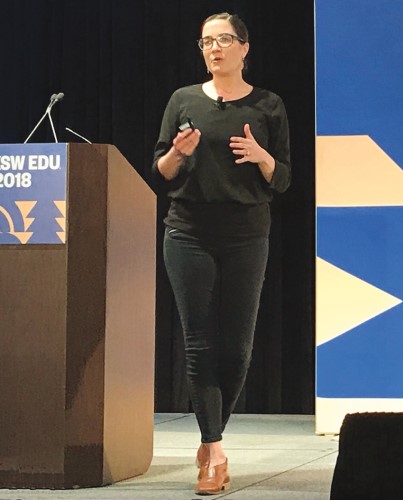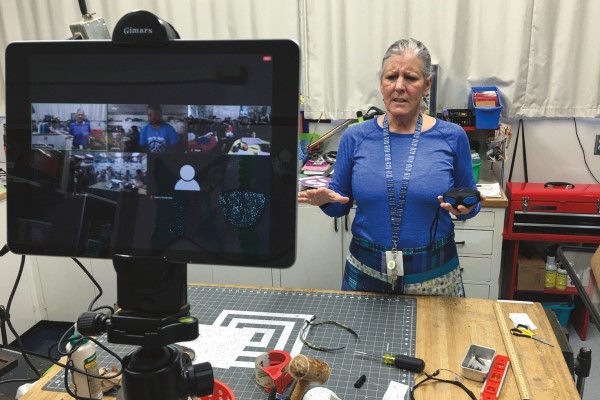The Making of a Networked School
October 01, 2019
As personal connections influence post-graduation life, school districts are exposing students to wider career options

John Dewey was one of the great minds that shaped education in the 20th century. He not only pushed our understanding of how children learn but also established the critical role that schools play in civil society and democracy.
How did the famed thinker land his first job? The answer may surprise you. Not unlike many of today’s millennials, Dewey spent the summer after college wondering what to do next. With few prospects, he wrangled a favor from his cousin, Affia Wilson, who was the principal of the public high school in Oil City, Pa. That fall, Dewey was hired to teach Latin, science and algebra, representing a third of the school’s faculty.
For all the promise he would later realize as a seminal leader and thinker, it was a relationship — rather than his innate abilities or passions alone — that landed Dewey his first job in a lifelong career in education.
Current Relevance
Fast forward nearly 150 years and Dewey’s story remains surprisingly contemporary. The ways in which young people pursue and gain access to professional opportunities are not marked merely by hard skills or even increasingly touted soft skills. In fact, according to Mark Granovetter, author of Getting a Job: A Study of Contacts and Careers, an estimated half of all jobs come through personal connections. Moreover, research suggests that a child’s network impacts her or his career path long before one submits a first job application. As it turns out, the careers kids are exposed to tend to shape the careers they pursue.
This means that what students know is only part of the equation. To help students effectively plan for their futures, schools need also to attend to whom students know. This is especially crucial if schools (and society) aim to help students explore and pursue careers beyond those occupations represented in their inherited networks.
Few school district leaders would dispute the value of students interacting with more real-life professionals across a range of fields. But that doesn’t make coordinating those connections easy or cheap on top of everything else on educators’
plates. Luckily for schools, a variety of promising, innovative models are emerging that focus on broadening students’ professional horizons and prospects. Crucially, these models don’t merely involve career-specific content but also yield
career-specific relationships.

Early Connections
In El Cajon, Calif., just 17 miles east of San Diego, one school district is doubling down on student networks and the career exposure they afford. The 17,000-student Cajon Valley Unified School District is on its third year of a K-8 relationship-based curriculum called the World of Work.
Cajon Valley’s superintendent, David Miyashiro, said the program’s goal “is to create relevance to the real world and enable students to map their educational goals to their possible future selves.”
World of Work integrates exposure to 54 distinct careers into students’ classroom experiences. As students dive into each of these various careers, they engage in Meet a Pro activities with real-world industry experts. Unlike one-off guest speakers, Cajon Valley embeds students’ encounters with professionals in a holistic curriculum. By the time students and teachers encounter a professional, the students already have explored careers with their teachers and even simulated what it’s like to work in that professional’s industry.
“We included Meet a Pro because of extensive research detailing the importance of students meeting professionals, ideally someone that looks like them, from the workforce and how it impacts their aspirations,” says Ed Hidalgo, the district’s chief innovation and engagement officer.
To address the logistical and cost barriers of bringing outsiders into classrooms, Cajon Valley turned to a technology tool called Nepris, which hosts an online marketplace of industry experts that teachers can port into their classrooms over video chat. Since January 2018, Cajon Valley students have logged more than 61,000 live chats with professionals. “[This platform] gives our teachers a superpower to source talent nationally to support this important element of the experience,” Hidalgo says.
Meet a Pro isn’t just connecting students with far-flung virtual professionals. It’s also unlocking an economy of scale when it comes to expanding students’ access to local, San Diego-area experts whom students might otherwise encounter only through hard-to-scale field trips. “We couldn’t take 1,700 students to the costume design studio at Lambs Players Theater, but that’s how many students were on Jemima Dutra’s live virtual chat. She’s a parent in our district and is now advocating for other district parents to join in,” Hidalgo says.
Nepris is in good company when it comes to the growing market of options for unlocking these connections. Educurious, a nonprofit best known for its project-based curriculum, created an “expert network” that pairs online experts with its projects to bring real-life perspectives and feedback to student work. Another organization, DreamWakers, also uses video chat to connect classrooms and industry, with a specific focus on linking students furthest from opportunity to online role models hailing from similar backgrounds.
Technologies such as these can surmount schools’ limits on time, money and geographic isolation to connect students more frequently across a diverse array of experts and role models.

Profession-Based Lessons
Other school districts are taking networking a step further by offering authentic, relationship-based career experience to high school students.
In 2009, Blue Valley School District near Kansas City, Mo., launched the Center for Advanced Professional Studies. The CAPS program offers half-day, semester-long coursework to high schoolers across the district in what it dubs “profession-based learning.” Unlike its close cousin, project-based learning, profession-based learning hinges on schools and businesses working together directly. For CAPS Executive Director Corey Mohn, that means that connecting coursework to professions can’t happen in a vacuum from connecting students directly to professionals.
To that end, roughly half of CAPS courses are taught by industry professionals who have stepped out of industry to teach. Additional opportunities to get to know working professionals throughout the semester abound. Students in the global business course connect with individual mentors in local industry and work in teams on 10-week client projects with a local employer. Students in the CAPS course on entrepreneurship experience what Mohn says are numerous “pop-in and pop-out” activities with an array of entrepreneurs from the community who offer real-world tips as students build their businesses.
“Typically these entrepreneurs are doing brief, spot-mentoring to describe what they do, their product creation cycles and their product-to-market strategies,” says Mohn.
Students in CAPS’ teacher education program work with educators right in their own district. For some students, such as Megan Holsapple, those connections outlast the coursework. Holsapple has since graduated, earned a bachelor’s degree in teaching and returned to Blue Valley to teach elementary school.
“By being a CAPS intern, I also had experiences that closely mirrored student teaching by working alongside district teachers and teaching lessons directly to students,” Holsapple says. “I still have connections to those teachers in the district today who have helped mold me by mentoring me long after I left CAPS.”
Today, districts in a wide range of geographies are borrowing from CAPS’ success. Blue Valley’s flagship program spawned The CAPS Network, a national network of profession-based learning programs that supports similar models in 52 affiliate programs across 102 school districts. Although the industries they focus on vary, all 52 programs are set up to ensure that students are engaging in coursework in relationship with their own local industry professionals.

Integrating Relationships
Do these sorts of relationships brokered in the course of career exposure and experiences pay dividends in the long run? Research suggests they do. An evaluation of career talks between students and professionals by a London-based advocacy group, Education and Employers, found increases in motivation and engagement, particularly among previously less-engaged, lower-performing students.
A 2012 study of three high schools in the Big Picture Learning network, in which students learn through personal interests and formal internships, found 74 percent of graduates who chose a career path immediately after high school secured their job through a connection they made in the course of their internship. And, “Pathways to High-Quality Jobs for Young Adults,” a report co-sponsored by Child Trends and Brookings’ Metropolitan Policy Program, found work-based learning experiences that specifically cultivated a relationship with either a mentor or a workplace supervisor predicted students securing quality employment a decade later.
Schools are no stranger to the special power of relationships. They deal in that power every day. But the exciting opportunity ahead is that innovations can double down on the
power of networks in students’ lives. Schools can invest more deeply in instructional models that deepen ties not just to real-world content but also real-world connections. Plus, they can deploy emerging technologies that expand students’
professional networks to new corners of the world — and the very communities in which they live — to pave the way to better long-term opportunities that networks can open up.
About the Author
Julia Freeland Fisher is the director of education research at the Clayton Christensen Institute in Lexington, Mass., and author of Who You Know: Unlocking Innovations That Expand Students’ Networks(Wiley 2018).
Additional Resources
Author Julia Freeland Fisher suggests these informational resources related to expanding students’ professional networks, in addition to her own book:
A searchable market map of educational technology that connects students to new relationships
Cajon Valley, Calif., School District’s Meet a Pro in action
Advertisement
Advertisement
Advertisement
Advertisement



